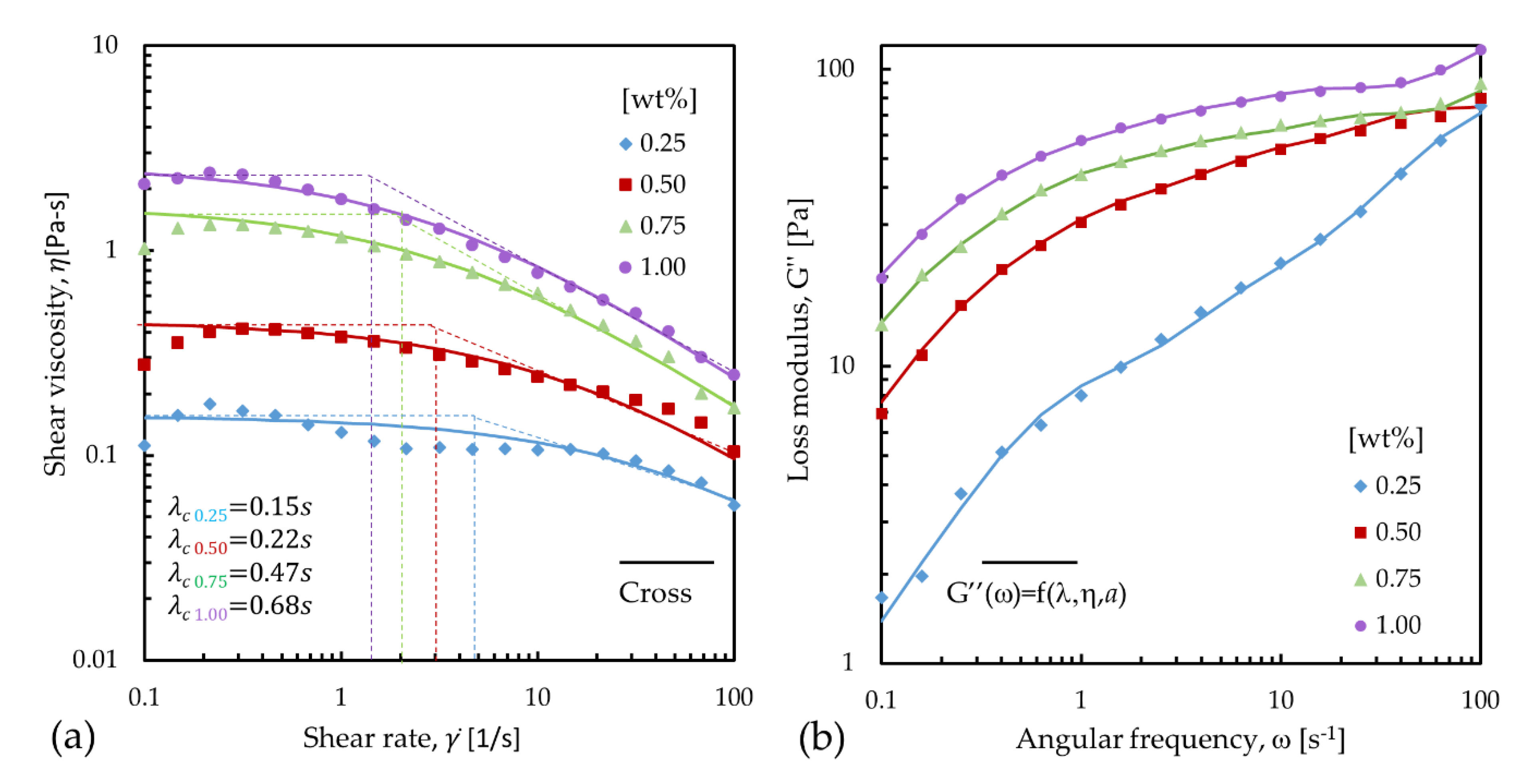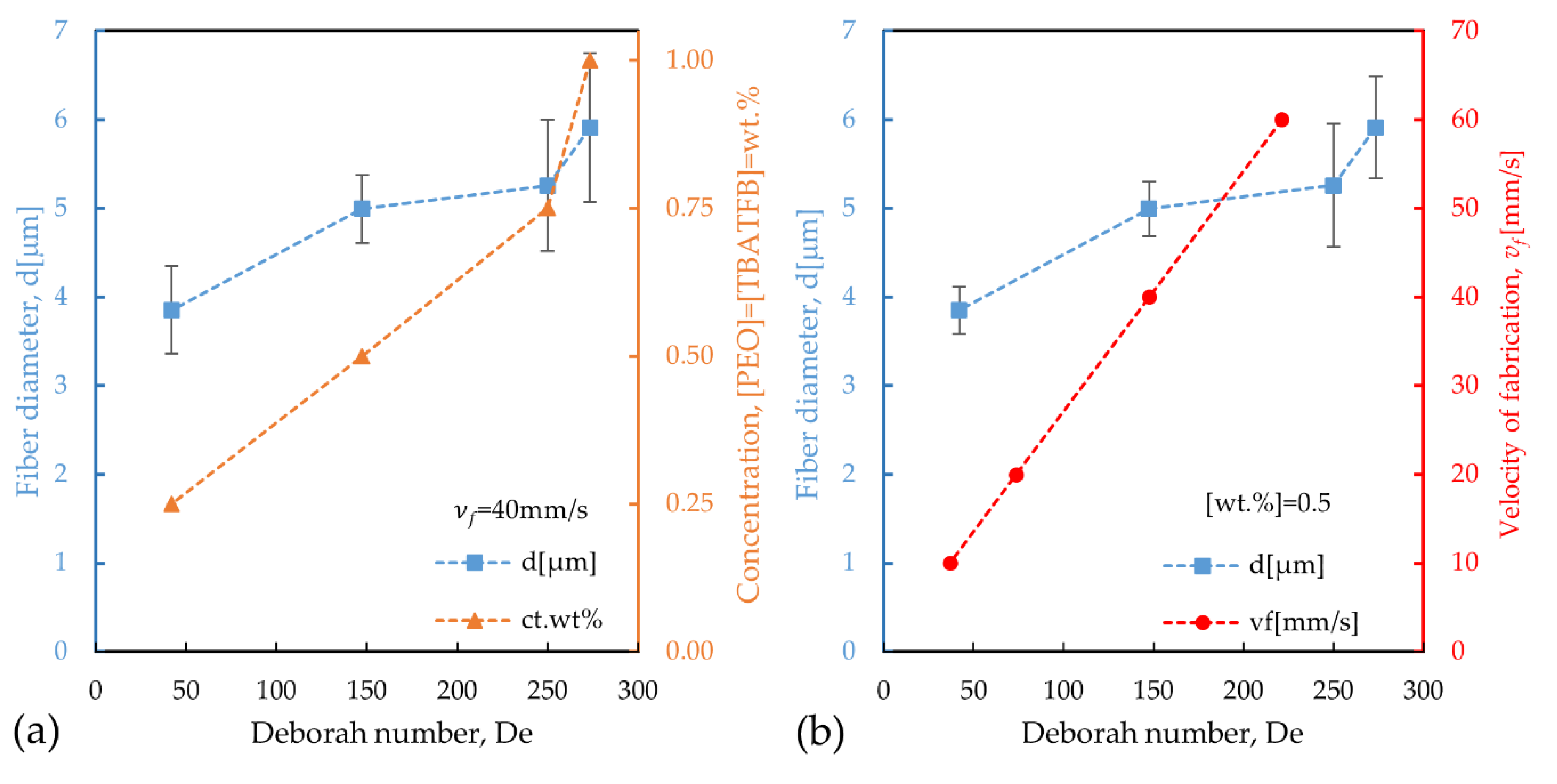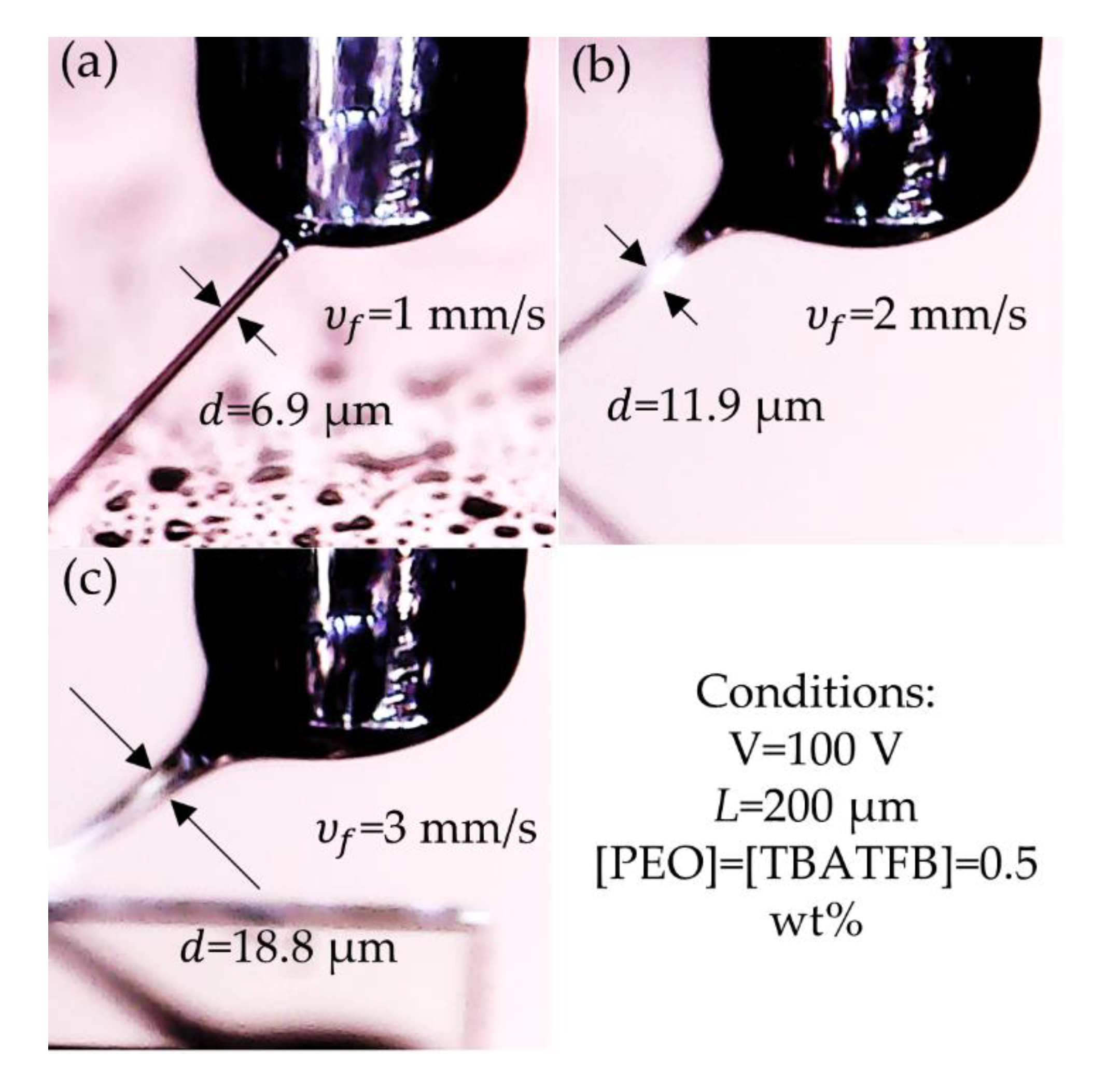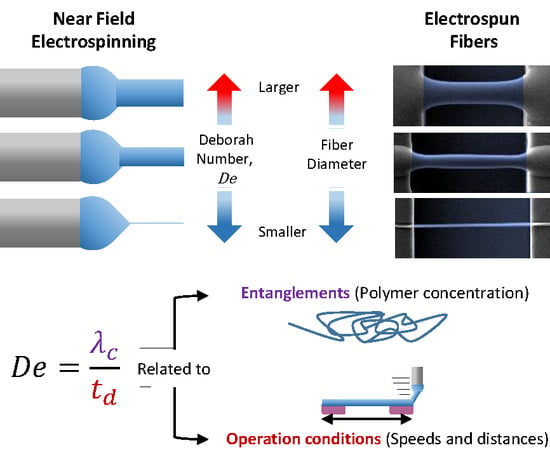Tailoring the Diameters of Electro-Mechanically Spun Fibers by Controlling Their Deborah Numbers
Abstract
:1. Introduction
2. Materials and Methods
2.1. Rheological Characterization of Polymer Solutions
2.2. Fiber Deposition Equipment
3. Results and Discussion
3.1. Polymer Solution Relaxation Times
3.2. Effect of Polymer Concentration and Speeds of Deposition on the Deborah Number
4. Conclusions
Supplementary Materials
Author Contributions
Funding
Acknowledgments
Conflicts of Interest
References
- Ramakrishna, S.; Fujihara, K.; Teo, W.E.; Yong, T.; Ma, Z.; Ramaseshan, R. Electrospun Nanofibers: Solving Global Issues. Mater. Today 2006, 9, 40–50. [Google Scholar] [CrossRef]
- Bisht, G.S.; Canton, G.; Mirsepassi, A.; Kulinsky, L.; Oh, S.; Dunn-Rankin, D.; Madou, M.J. Controlled Continuous Patterning of Polymeric Nanofibers on Three-Dimensional Substrates Using Low-Voltage Near-Field Electrospinning. Nano Lett. 2011, 11, 1831–1837. [Google Scholar] [CrossRef]
- Reneker, D.H.; Yarin, A.L. Electrospinning Jets and Polymer Nanofibers. Polymer 2008, 49, 2387–2425. [Google Scholar] [CrossRef] [Green Version]
- Reneker, D.H.; Yarin, A.L.; Zussman, E.; Xu, H. Electrospinning of Nanofibers from Polymer Solutions and Melts. Adv. Appl. Mech. 2007, 41, 43–346. [Google Scholar]
- Ferrer-Argemi, L.; Aliabadi, E.S.; Cisquella-Serra, A.; Salazar, A.; Madou, M.; Lee, J. Size-Dependent Electrical and Thermal Conductivities of Electro-Mechanically-Spun Glassy Carbon Wires. Carbon 2018, 130, 87–93. [Google Scholar] [CrossRef]
- He, X.X.; Zheng, J.; Yu, G.; You, M.H.; Yu, M.; Ning, X.; Long, Y.Z. Near-Field Electrospinning: Progress and Applications. J. Phys. Chem. C 2017, 16, 8663–8678. [Google Scholar] [CrossRef]
- Persano, L.; Camposeo, A.; Tekmen, C.; Pisignano, D. Industrial Upscaling of Electrospinning and Applications of Polymer Nanofibers: A Review. Macromol. Mater. Eng. 2013, 298, 504–520. [Google Scholar] [CrossRef]
- Thiha, A.; Ibrahim, F.; Muniandy, S.; Dinshaw, I.J.; Teh, S.J.; Thong, K.L.; Leo, B.F.; Madou, M. All-Carbon Suspended Nanowire Sensors as a Rapid Highly-Sensitive Label-Free Chemiresistive Biosensing Platform. Biosens. Bioelectron. 2018, 107, 145–152. [Google Scholar] [CrossRef]
- Li, X.; Li, Z.; Wang, L.; Ma, G.; Meng, F.; Pritchard, R.H.; Gil, E.L.; Liu, Y.; Yan, Y.; Huang, S. Low-Voltage Continuous Electrospinning Patterning. ACS Appl. Mater. Interfaces 2016, 8, 32120–32131. [Google Scholar] [CrossRef] [Green Version]
- Canton, G.; Do, T.; Kulinsky, L.; Madou, M. Improved Conductivity of Suspended Carbon Fibers Through Integration of C-MEMS and Electro-Mechanical Spinning Technologies. Carbon 2014, 71, 338–342. [Google Scholar] [CrossRef]
- Wang, H.; Huang, S.; Liang, F.; Wu, P.; Li, M.; Lin, S.; Chen, X. Research on Multinozzle Near-Field Electrospinning Patterned Deposition. J. Nanomater. 2015, 2015, 529138. [Google Scholar] [CrossRef]
- Chang, C.; Limkrailassiri, K.; Lin, L. Continuous Near-Field Electrospinning for Large Area Deposition of Orderly Nanofiber Patterns. Appl. Phys. Lett. 2008, 93, 123111. [Google Scholar] [CrossRef] [Green Version]
- Ebagninin, K.W.; Benchabane, A.; Bekkour, K. Rheological Characterization of Poly(Ethylene Oxide) Solutions of Different Molecular Weights. J. Colloid Interface Sci. 2009, 336, 360–367. [Google Scholar] [CrossRef]
- Formenti, S.; Castagna, R.; Momentè, R.; Bertarelli, C.; Briatico-Vangosa, F. The Relevance of Extensional Rheology on Electrospinning: The Polyamide/Iron Chloride Case. Eur. Polym. J. 2016, 75, 46–55. [Google Scholar] [CrossRef] [Green Version]
- Hodgkinson, T.; Chen, Y.; Bayat, A.; Yuan, X.-F. Rheology and Electrospinning of Regenerated Bombyx mori Silk Fibroin Aqueous Solutions. Biomacromolecules 2014, 15, 1288–1298. [Google Scholar] [CrossRef]
- Shenoy, S.L.; Bates, W.D.; Frisch, H.L.; Wnek, G.E. Role of Chain Entanglements on Fiber Formation During Electrospinning of Polymer Solutions: Good Solvent, Non-Specific Polymer–Polymer Interaction Limit. Polymer 2005, 46, 3372–3384. [Google Scholar] [CrossRef]
- McKee, M.G.; Wilkes, G.L.; Colby, R.H.; Long, T.E. Correlations of Solution Rheology with Electrospun Fiber Formation of Linear and Branched Polyesters. Macromolecules 2004, 37, 1760–1767. [Google Scholar] [CrossRef]
- Klossner, R.R.; Queen, H.A.; Coughlin, A.J.; Krause, W.E. Correlation of Chitosan’s Rheological Properties and its Ability to Electrospin. Biomacromolecules 2008, 9, 2947–2953. [Google Scholar] [CrossRef]
- Carroll, C.P.; Joo, Y.L. Electrospinning of viscoelastic Boger fluids: Modeling and experiments. Phys. Fluids 2006, 18, 053102. [Google Scholar] [CrossRef]
- Yu, J.H.; Fridrikh, S.V.; Rutledge, G.C. The role of elasticity in the formation of electrospun fibers. Polymer 2006, 47, 4789–4797. [Google Scholar] [CrossRef]
- Ru, C.; Chen, J.; Shao, Z.; Pang, M.; Luo, J. A novel mathematical model for controllable near-field electrospinning. AIP Adv. 2014, 4, 017108. [Google Scholar] [CrossRef]
- Gupta, D.; Jassal, M.; Agrawal, A.K. Electrospinning of poly(vinyl alcohol)-based boger fluids to understand the role of elasticity on morphology of nanofibers. Ind. Eng. Chem. Res. 2015, 54, 1547–1554. [Google Scholar] [CrossRef]
- Gadkari, S. Influence of polymer relaxation time on the electrospinning process: Numerical investigation. Polymers 2017, 9, 501. [Google Scholar] [CrossRef] [Green Version]
- Fang, F.; Chen, X.; Du, Z.; Zhu, Z.; Chen, X.; Wang, H.; Wu, P. Controllable Direct-Writing of Serpentine Micro/Nano Structures via Low Voltage Electrospinning. Polymers 2015, 7, 1577–1586. [Google Scholar] [CrossRef] [Green Version]
- Liu, Z.H.; Pan, C.T.; Lin, L.W.; Huang, J.C.; Ou, Z.Y. Direct-Write PVDF Nonwoven Fiber Fabric Energy Harvesters via the Hollow Cylindrical near-Field Electrospinning Process. Smart Mater. Struct. 2013, 23, 025003. [Google Scholar] [CrossRef]
- Sun, D.; Chang, C.; Li, S.; Lin, L. Near-Field Electrospinning. Nano Lett. 2006, 6, 839–842. [Google Scholar] [CrossRef] [Green Version]
- Zhou, F.-L.; Hubbard, P.L.; Eichhorn, S.J.; Parker, G.J.M. Jet Deposition in Near-Field Electrospinning of Patterned Polycaprolactone and Sugar-Polycaprolactone Core–shell Fibres. Polymer 2011, 52, 3603–3610. [Google Scholar] [CrossRef]
- Salazar, A.; Cardenas-Benitez, B.; Pramanick, B.; Madou, M.J.; Martinez-Chapa, S.O. Nanogap Fabrication by Joule Heating of Electromechanically Spun Suspended Carbon Nanofibers. Carbon 2017, 115, 811–818. [Google Scholar] [CrossRef] [Green Version]
- Yang, Y.; Jia, Z.; Li, Q.; Guan, Z. Experimental Investigation of the Governing Parameters in the Electrospinning of Polyethylene Oxide Solution. IEEE Trans. Dielectr. Electr. Insul. 2006, 13, 580–584. [Google Scholar] [CrossRef]








| Technique | Polymer/Solvent/Additive | Voltage, V [kV] | Deposition Speed, vf [mm/s] | Concentration [wt%] | Fibers Diameter, d [µm] | Velocity-Diameter Effect | Concentration-Diameter Effect | Deborah Number, De | Ref. |
|---|---|---|---|---|---|---|---|---|---|
| LVNFES | PEO/DI Water/- | 0.2–0.4 | 20–40 | 1–3 | 0.05–0.425 | d∝1/v | d∝c | Correlates the relaxation time with the entanglement of the polymer network, but provides no further analysis | [2] |
| LVNFES | PEO/DIW/- | 1.5 | 0–6.6 | 3–8 | - | - | - | - | [24] |
| LVNFES | PEO/Water/- | 0.05–0.15 | 100 | 3–10 | 0.1–0.3 | - | d∝c | - | [9] |
| PVP/EtOh/- | 0.05–0.20 | 15–25 | 1–2 | ||||||
| PS/DMF/- | 0.05–0.70 | 20–30 | 0.5–1.2 | ||||||
| Gelatin/HOAc-EtOAc/- | 0.10–0.15 | 19 | - | ||||||
| LVNFES | PEO/SU-8 2002/TBATFB | 0.1 | 1–60 | 0.25–1.00 | 0.976–7 | d∝v | d∝c | d∝De in Contact-LVNFES | This work |
| HCNFES | PVDF/Dimethyl sulfoxide/ZONYL and acetone | 10-16 | 942–1989 | 16–20 | 0.1–1.2 | d∝1/v | N/A | - | [25] |
| NFES | PEO/DIW/- | 1 | 50–250 | 3–5 | 0.3 | - | d∝c | - | [26] |
| NFES | PEO/DI W/- | 0.6-1.2 | 120 | 03–09 | 0.04-2.3 | N/A | d∝c | - | [12] |
| NFES | PCL/Chloroform and N,N-dimethyl-formamide/none | 2 | 20–45 | 10 | 6–32 | d∝1/v | N/A | - | [27] |
| NFES | PEO/DIW/EtOH | 1.5 | 3.82–8.59 | 4 | 1.75–4.76 | d∝1/v | N/A | De, is used within a momentum balance equation. De effects on the | [21] |
| FFES | PIB/PB | 9-13 | N/A | 2k,4k,8k ppm | 0.08–0.30 | N/A | d∝c | d∝De for FFES | [19] |
| FFES | PEO/DIW/PEG | - | N/A | 0.1–0.2 | 2.7–9.5 | N/A | d∝c | De and its influence over electrospinning process is deeply studied for FFES. They Define critical De values to obtain uniform fibers. | [20] |
| FFES | LMwPVA/DIW/HMwPVA | 17-32 | N/A | 26–34 | 0.066–0.325 | N/A | d∝c | d∝De in FFES | [22] |
| Solution | Concentration [wt%] | ||
|---|---|---|---|
| SU-8 | PEO | TBATFB | |
| 1 | 99.50 | 0.25 | 0.25 |
| 2 | 99.00 | 0.50 | 0.50 |
| 3 | 98.50 | 0.75 | 0.75 |
| 4 | 98.00 | 1.00 | 1.00 |
| Concentration [wt%] | Velocity of Deposition [mm/s] | |||||||||
|---|---|---|---|---|---|---|---|---|---|---|
| Solution | SU-8 | PEO | TBATFB | 60 | 40 | 20 | 10 | 5 | 1 | 0.5 |
| 1 | 99.5 | 0.25 | 0.25 | A | C | C | C | C | ||
| 2 | 99.0 | 0.50 | 0.50 | B | A/B | B | ||||
| 3 | 98.5 | 0.75 | 0.75 | A | ||||||
| 4 | 98.0 | 1.00 | 1.00 | A | ||||||
| Solution | Relaxation Time, λc [s] | ||
|---|---|---|---|
| Cross | Graphical | H(λ) | |
| 0.25 | 0.02 | 0.15 | 0.21 |
| 0.50 | 0.07 | 0.22 | 0.74 |
| 0.75 | 0.25 | 0.47 | 1.25 |
| 1.00 | 0.31 | 0.68 | 1.37 |
| Velocity of Fabrication, υf [mm/s] | Concentration [PEO = TBATF]=wt% | Critical Relaxation Time, λc [s] | Deposition Time, td [s] | Deborah Number, De | Average Diameter of Fibers, d [µm] | Std. Dev., [µm] |
|---|---|---|---|---|---|---|
| 40 | 1.00 | 1.37 | 0.005 | 273.44 | 5.912 | 0.839 |
| 40 | 0.75 | 1.25 | 0.005 | 249.95 | 5.259 | 0.742 |
| 40 | 0.50 | 0.74 | 0.005 | 147.41 | 4.992 | 0.386 |
| 40 | 0.25 | 0.21 | 0.005 | 41.99 | 3.854 | 0.493 |
| 60 | 0.50 | 0.74 | 0.003 | 221.12 | 5.141 | 0.577 |
| 40 | 0.50 | 0.74 | 0.005 | 147.41 | 4.957 | 0.694 |
| 20 | 0.50 | 0.74 | 0.010 | 73.71 | 4.505 | 0.305 |
| 10 | 0.50 | 0.74 | 0.020 | 36.85 | 4.198 | 0.267 |
| 10 | 0.25 | 0.21 | 0.020 | 10.50 | 2.502 | 0.301 |
| 5 | 0.25 | 0.21 | 0.040 | 5.25 | 1.406 | 0.184 |
| 1 | 0.25 | 0.21 | 0.200 | 1.05 | 1.016 | 0.153 |
| 0.5 | 0.25 | 0.21 | 0.400 | 0.52 | 2.331 | 0.351 |
© 2020 by the authors. Licensee MDPI, Basel, Switzerland. This article is an open access article distributed under the terms and conditions of the Creative Commons Attribution (CC BY) license (http://creativecommons.org/licenses/by/4.0/).
Share and Cite
Flores-Hernandez, D.R.; Cardenas-Benitez, B.; Martinez-Chapa, S.O.; Bonilla-Rios, J. Tailoring the Diameters of Electro-Mechanically Spun Fibers by Controlling Their Deborah Numbers. Polymers 2020, 12, 1358. https://doi.org/10.3390/polym12061358
Flores-Hernandez DR, Cardenas-Benitez B, Martinez-Chapa SO, Bonilla-Rios J. Tailoring the Diameters of Electro-Mechanically Spun Fibers by Controlling Their Deborah Numbers. Polymers. 2020; 12(6):1358. https://doi.org/10.3390/polym12061358
Chicago/Turabian StyleFlores-Hernandez, Domingo R., Braulio Cardenas-Benitez, Sergio O. Martinez-Chapa, and Jaime Bonilla-Rios. 2020. "Tailoring the Diameters of Electro-Mechanically Spun Fibers by Controlling Their Deborah Numbers" Polymers 12, no. 6: 1358. https://doi.org/10.3390/polym12061358






